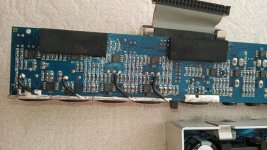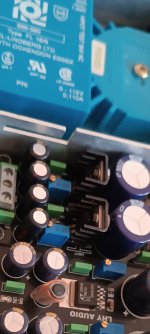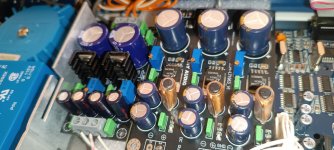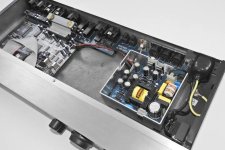Depends very much how many ma you draw from the opa1656.
Edit: data sheet says 3.9 mA per channel quiescent current, for total current draw just add the current drawn from the load(s)
Edit: data sheet says 3.9 mA per channel quiescent current, for total current draw just add the current drawn from the load(s)
Last edited:
That question has been asked before and the answer was it draws 3.9 mA per channel so let's say 8 mA for 1 opamp. That will still be the case as things haven't changed.How many mA does 1 opa1656 opamp draw from the transformer?
Maybe you can do the work and find out what the current draw of the existing opamps is? You know OPA1656 draws 8 mA. Possibly the PSU also feeds other sections so most handy is to compare the old and the new opamps.
The 2 x 12V AC 2 x 417 mA 10VA transformer can deliver about 2 x 300 mA into rectifiers/filter caps + load continuously but it is better to stay below that. I would derate to 2 x 200...250 mA.
Are the current opamps defective? If they are OK there probably is no need to replace these for 50 MHz capable CMOS opamps and have the risk of defects because of being unexperienced, ESD, oscillation etc. Opamp rolling is pretty useless when not looking at how stuff is implemented. It is like replacing the motor of your washing machine for a random other one expecting improvement and whiter than white bed sheets.
Last edited:
Rectification means you need about 50% margin on current.
First it is the 1.41VxVAC that gives you the DC. Then the charging current rms of the.capacitors is larger than DC current draw.
Transformers are actually current limited.
So 11 OP at 8 mA = 88 mA.
Transformer is 420mA, so I say about 250mA DC current draw is safe, plenty of margin thus
We know nothing about OP load and circuit so it is hard to say how much they actually draw including loading.
First it is the 1.41VxVAC that gives you the DC. Then the charging current rms of the.capacitors is larger than DC current draw.
Transformers are actually current limited.
So 11 OP at 8 mA = 88 mA.
Transformer is 420mA, so I say about 250mA DC current draw is safe, plenty of margin thus
We know nothing about OP load and circuit so it is hard to say how much they actually draw including loading.
You could try to at least write stuff correctly.I also have a 2x15v ac 10va 2x333.0 mA transformer
Thanks, right now 11 jrc4580s are connected, +15v 90mA, -15v 90mA is drawing current.That question has been asked before and the answer was it draws 3.9 mA per channel so let's say 8 mA for 1 opamp. That will still be the case as things haven't changed.
Maybe you can do the work and find out what the current draw of the existing opamps is? You know OPA1656 draws 8 mA. Possibly the PSU also feeds other sections so most handy is to compare the old and the new opamps.
The 2 x 12V AC 2 x 417 mA 10VA transformer can deliver about 2 x 300 mA into rectifiers/filter caps + load continuously but it is better to stay below that. I would derate to 2 x 200...250 mA.
Are the current opamps defective? If they are OK there probably is no need to replace these for 50 MHz capable CMOS opamps and have the risk of defects because of being unexperienced, ESD, oscillation etc. Opamp rolling is pretty useless when not looking at how stuff is implemented. It is like replacing the motor of your washing machine for a random other one expecting improvement and whiter than white bed sheets.
The current opamps are solid, I have a sample opa1656 from jrc4580 behringer deq2496 ti, I thought I would evaluate it.That question has been asked before and the answer was it draws 3.9 mA per channel so let's say 8 mA for 1 opamp. That will still be the case as things haven't changed.
Maybe you can do the work and find out what the current draw of the existing opamps is? You know OPA1656 draws 8 mA. Possibly the PSU also feeds other sections so most handy is to compare the old and the new opamps.
The 2 x 12V AC 2 x 417 mA 10VA transformer can deliver about 2 x 300 mA into rectifiers/filter caps + load continuously but it is better to stay below that. I would derate to 2 x 200...250 mA.
Are the current opamps defective? If they are OK there probably is no need to replace these for 50 MHz capable CMOS opamps and have the risk of defects because of being unexperienced, ESD, oscillation etc. Opamp rolling is pretty useless when not looking at how stuff is implemented. It is like replacing the motor of your washing machine for a random other one expecting improvement and whiter than white bed sheets.
NJM4580 in SMD or TH? If 11 of these connected to +/- 15V consume 90 mA then 11 x OPA1656 will not be an issue with regards to current.
However they are way faster/higher bandwidth than NJM4580..... don't know the device but what is it you want to achieve? NJM4580 is used a lot in pro audio as the numbers are usually high and the costs of opamps a key parameter. I don't like NJM4580 but maybe OPA1656 is too much of a risk.
However they are way faster/higher bandwidth than NJM4580..... don't know the device but what is it you want to achieve? NJM4580 is used a lot in pro audio as the numbers are usually high and the costs of opamps a key parameter. I don't like NJM4580 but maybe OPA1656 is too much of a risk.
Last edited:
I will use 11 opa1656 for behringer deq2496Rectification means you need about 50% margin on current.
First it is the 1.41VxVAC that gives you the DC. Then the charging current rms of the.capacitors is larger than DC current draw.
Transformers are actually current limited.
So 11 OP at 8 mA = 88 mA.
Transformer is 420mA, so I say about 250mA DC current draw is safe, plenty of margin thus
We know nothing about OP load and circuit so it is hard to say how much they actually draw including loading.
SmdNJM4580 in SMD or TH?
Attachments
OPA1642 is much more of a suitable replacement it seems. Sounds and measures pretty well too. Only 1.8 mA per channel so 4 mA per opamp -> better.
Anyway, this was enough of my time. Please be careful and use desoldering braid when removing SMD opamps and make sure you work ESD safe.
Again, please consider writing technical terms correctly. You will gain respect, attract nice beta girls (with cute glasses!), get free beer from engineers instead of being looked at as being illiterate.
Anyway, this was enough of my time. Please be careful and use desoldering braid when removing SMD opamps and make sure you work ESD safe.
Again, please consider writing technical terms correctly. You will gain respect, attract nice beta girls (with cute glasses!), get free beer from engineers instead of being looked at as being illiterate.
Last edited:
Jean-Paul
3 opamps for input, 4 opamps for output, 2 opamps for DAC, 2 opamps for aux. I have 6 opa1612 and 4 opa2134 smd. I took it as a ti sample. What would happen if I used different opamps for input and different opamps for output?
3 opamps for input, 4 opamps for output, 2 opamps for DAC, 2 opamps for aux. I have 6 opa1612 and 4 opa2134 smd. I took it as a ti sample. What would happen if I used different opamps for input and different opamps for output?
Only the spaghetti monster knows as it is pretty dumb to throw both random and different opamps in a now well working/measuring device. Would you mount 4 different brand tires to your car? 4 random spark plugs with different part numbers? Which one for cylinder 1? And 2? Which one made a cilinder fire better?
Any of such attempts should start with reading datasheets and comparing. Then changing, testing, verifying. Not by asking here how stuff should be done and still just do something. Or if that knowledge/experience is simple lacking (it happens, we all have different talents) just play safe and use an issue free recent better specced workhorse.
You got the answer to the thread titles question. Good luck!
Any of such attempts should start with reading datasheets and comparing. Then changing, testing, verifying. Not by asking here how stuff should be done and still just do something. Or if that knowledge/experience is simple lacking (it happens, we all have different talents) just play safe and use an issue free recent better specced workhorse.
You got the answer to the thread titles question. Good luck!
Last edited:
There are 2 transformers 2x12v ac 10va and 2x15v ac 10vaYou could try to at least write stuff correctly.
It's pointless to mix opamps with car wheelsOnly the spaghetti monster knows as it is pretty dumb to throw both random and different opamps in a now well working/measuring device. Would you mount 4 different brand tires to your car? 4 random spark plugs with different part numbers? Which one for cylinder 1? And 2? Which one made a cilinder fire better?
Any of such attempts should start with reading datasheets and comparing. Then changing, testing, verifying. Not by asking here how stuff should be done and still just do something. Or if that knowledge/experience is simple lacking (it happens, we all have different talents) just play safe and use an issue free recent better specced workhorse.
You got the answer to the thread titles question. Good luck!
- Home
- Source & Line
- Analog Line Level
- How many mA does 1 opa1656 opamp draw from the transformer?



